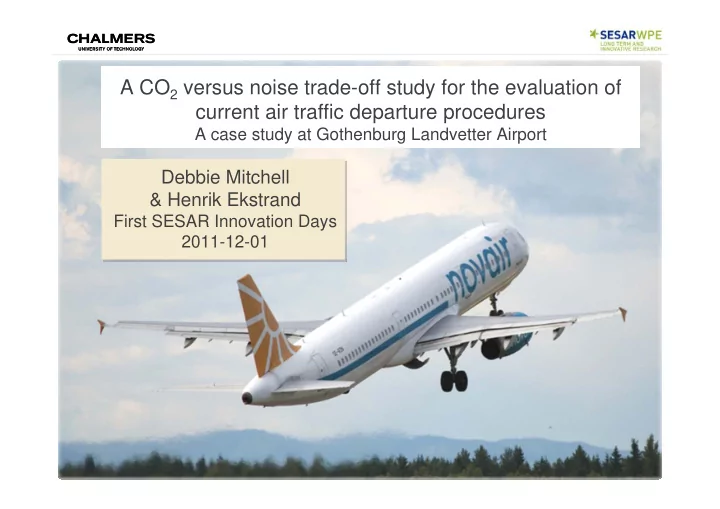

A CO 2 versus noise trade-off study for the evaluation of current air traffic departure procedures A case study at Gothenburg Landvetter Airport Debbie Mitchell • Click to edit Master text styles & Henrik Ekstrand First SESAR Innovation Days – Second level 2011-12-01 • Third level – Fourth level » Fifth level 1 12/7/2011
Outline Outline • Motivation for study • Green departures • Overview of turn ‐ related speed constraints • Case study: Gothenburg Landvetter Airport • Speed constraints on TOPLA 1M SID • Speed constraint scenarios modelled • Data and aircraft performance/noise modelling • Results – CO 2 versus noise trade ‐ off study • Conclusions • Possible solutions for removal of SID speed constraints
Motivation SESAR target 10% CO 2 via ATM improvements by 2020 Historically emphasis on reducing noise exposure around airports. Procedures based on old Potential for substantial fuel aircraft types savings
Issues • Are some ATM procedures overly conservative? • Are procedures designed to mitigate against noise having an unacceptable affect on CO 2 emissions? • What effect is this having on the environment?
What constitutes a ‘green departure’? • Continuous climb departures. • Direct routing (effective ATC coordination). • Variable SID deviation altitudes. • Minimum take ‐ off thrust and reduced climb thrust. • Low thrust cutback altitude. • Green speed. • Optimise use of PANS ‐ OPS Doc. 8168.
Turn ‐ related speed constraints • Track change of turn • Altitude • Assumed met conditions • Max. allowed aircraft bank angle
Fuel burn penalty of turn ‐ related speed restrictions Slat retraction usually Flap retraction >210 KIAS for heavy aircraft >210 KIAS
Case study: Gothenburg Landvetter Airport (ESGG) RWY21 ESGG RWY03
TOPLA 1M departure route 210 KIAS speed constraint 210
Speed constraint scenarios 1. 205 KIAS to 10 NM 2. 210 KIAS to 10 NM 3. 220 KIAS to 10 NM 4. 250 KIAS to Flight Level 100 5. Free Speed (no constraints)
Data • Flight Data Recorder data from Novair. • Novair A321 departures along TOPLA 1M SID (RWY 03). Parameter Winter flight • Take ‐ Off Data Calculation (TODC) data. Take-off mass 85,500 kg • Meteorological data. V ROTATE 168 KIAS V 2 175 KIAS • Selected initial conditions for typical Winter Initial aircraft configuration CONF 1+F flight. Thrust setting TOGA Air conditioning Off Engine Anti Ice On Outside Air Temperature 0 QNH 1008
Aircraft performance modelling • Operational Flight Performance (OFP) tool in Airbus Performance Engineers Program ( PEP ). • Replicate actual flights based on manufacturer’s data.
Aircraft PEP model validation • Ensured PEP climb profile in good agreement with the FDR data. • Made deviations in PEP by changing speed constraints.
Aircraft noise modelling • Airbus Noise Level (NLC) tool. • Noise calculations based on manufacturer’s Noise Power Distance tables. • Assume microphone location 1.2 m above ground level (ICAO Annex 16) and directly under flight path. • Maximum A ‐ Weighted Audible Noise (LA max ) metric used for analysis (metric used in Sweden).
Data analysis
Speed Constraint Scenarios ‐ Results • Climb profiles consistent until 5 NM and 2300 ft AGL. • 205 KIAS scenario has highest altitude between 5 NM and 12 NM. • 250 KIAS and Free Speed scenarios identical until 7 NM and 2800 ft AGL. • Free Speed profile has lowest climb angle during initial climb phase.
Speed Constraint Scenarios ‐ Results • Distances >7 NM Free Speed scenario generates highest LA max . • Explained by climb profile of aircraft. • Similar noise profiles for remaining 4 scenarios above 10 NM ground distance.
Surface area of LA max noise contour (km 2 ) Speed restriction scenario 75 dB(A) 70 dB(A) 65 dB(A) 60 dB(A) 205 KIAS to 10 NM 7.07 14.38 31.30 75.20 210 KIAS to 10 NM 7.07 14.34 31.46 75.45 220 KIAS to 10 NM 7.07 14.51 34.26 74.77 250 KIAS to FL 100 7.07 14.42 35.54 73.60 Free Speed 7.07 14.42 41.69 93.32
CO 2 vs. Noise Trade ‐ Off Analysis – Results • Potential for CO 2 savings of ~180 kg per flight if remove 210 KIAS and 250 KIAS speed constraints on LABAN 1M SID (~60 kg fuel). • Increase in noise ranging between 2 dB(A) – 5 dB(A) during initial climb depending on position along flight path.
Speed Constraint Analysis ‐ Conclusions • Free Speed means aircraft stays closer to ground during initial climb – affect on noise profile. • Does not affect noise contours above 70 dB(A), i.e. loudest noise range, but reducing speed restrictions causes increases in noise below 65 dB(A) contour level (increase in surface area of 18.12 km 2 ). • Potential fuel savings ~60 kg for heavy A321 winter flight and ~180 kg reduction in CO 2 , but increase in noise 2 dB(A) – 5 dB(A) depending on position along flight path. ~3500 departures along TOPLA 1M per year ~190 tonnes of fuel • savings and ~ 575 tonnes of CO 2 .
Possible solutions for removal of SID speed constraints • Remove turn-related speed constraints applied to SIDs as significant environmental benefit. • Optimise use of PANS-OPS 8168: • Use of statistical wind. Allow aircraft capable of banking 30 ° to fly turn without • speed restriction (state in AIP). • Deviate from PANS-OPS by proving track adherence via flight trials.
Track ‐ keeping adherence
QUESTIONS? QUESTIONS? Email: deborah.mitchell@chalmers.se
Recommend
More recommend